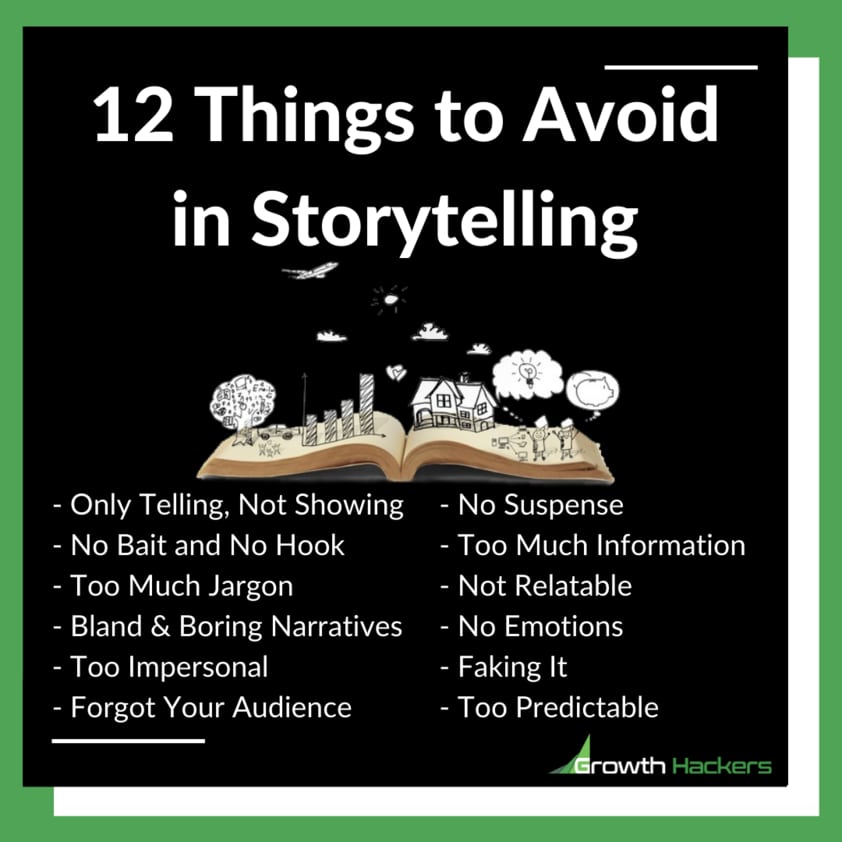Brand Storytelling 101
To anyone who isn’t so familiar with the concept, here are the basics of brand storytelling you need to know before we dive into its dos and don’ts.
Ever since the start of human civilization, sharing stories has been a significant ritual in various communities. Historically, storytelling was used as a community-building tool as it allowed for the circulation of ideas, experiences, and emotions amongst people. In such a highly digitalized generation, storytelling provides us with a refreshing touch of humanity that we, as a society, find comfort in.
A decade ago, brand storytelling was considered by marketers as an added quality to a business, an enhancing strategy that could help bring more attention to the brand. Today, it has become a necessity.
But what exactly is brand storytelling?
Think of brand storytelling as your company’s personal anecdote. It’s all about sharing your brand’s background story, heritage, culture, and values. It provides customers with deeper insights about the brand and its products, but most importantly, why the brand matters.
Every company has its own unique mission and vision. Their purpose and the solutions they attempt to provide society all differ from one another. To survive in the over-crowded marketplace, brand storytelling became a highly effective marketing strategy used to communicate these motivations. Rather than making customers feel like they are explicitly being marketed to, storytelling helps brands develop meaningful relationships with their audiences.
Besides, it has been revealed that stories are actually 22 times more memorable than facts and figures. They capture consumers' attention and heavily impact their perceptions of the brand. If the story were to leave a positive impression, this can further lead to increased awareness, conversion, and loyalty.
Although brand storytelling has become mandatory for many businesses, having a story is simply not enough. You need a good story. As daily listeners of stories, it has become almost a natural instinct in humans to know how to distinguish between good and bad stories. We’ve all heard them before.
Customers will treat and react to your stories the same way. They engage with brands through stories that leave them with a valuable message, one that they will remember and benefit from. A bad story or the lack of any story at all, on the other hand, can be a recipe for marketing failure.
To make it easier to digest, here is a list of the dos and don’ts of brand storytelling:
Ever since the start of human civilization, sharing stories has been a significant ritual in various communities. Historically, storytelling was used as a community-building tool as it allowed for the circulation of ideas, experiences, and emotions amongst people. In such a highly digitalized generation, storytelling provides us with a refreshing touch of humanity that we, as a society, find comfort in.
A decade ago, brand storytelling was considered by marketers as an added quality to a business, an enhancing strategy that could help bring more attention to the brand. Today, it has become a necessity.
But what exactly is brand storytelling?
Think of brand storytelling as your company’s personal anecdote. It’s all about sharing your brand’s background story, heritage, culture, and values. It provides customers with deeper insights about the brand and its products, but most importantly, why the brand matters.
Every company has its own unique mission and vision. Their purpose and the solutions they attempt to provide society all differ from one another. To survive in the over-crowded marketplace, brand storytelling became a highly effective marketing strategy used to communicate these motivations. Rather than making customers feel like they are explicitly being marketed to, storytelling helps brands develop meaningful relationships with their audiences.
Besides, it has been revealed that stories are actually 22 times more memorable than facts and figures. They capture consumers' attention and heavily impact their perceptions of the brand. If the story were to leave a positive impression, this can further lead to increased awareness, conversion, and loyalty.
Although brand storytelling has become mandatory for many businesses, having a story is simply not enough. You need a good story. As daily listeners of stories, it has become almost a natural instinct in humans to know how to distinguish between good and bad stories. We’ve all heard them before.
Customers will treat and react to your stories the same way. They engage with brands through stories that leave them with a valuable message, one that they will remember and benefit from. A bad story or the lack of any story at all, on the other hand, can be a recipe for marketing failure.
To make it easier to digest, here is a list of the dos and don’ts of brand storytelling:

The Do's
1) Know Your Company and Customers
Knowing your position is essential to successful branding and/or re-branding. Be an expert of your company. Know its background, goals, brand voice and customers from the inside out. You need to be aware of what your brand, as well as your customers, stand for.A good tip would be to keep close contact with your company’s customer service employees. These are the people that constantly interact with your customers on a day-to-day basis. Therefore, they are the ones that will know your customers needs and desires best and will be of great value when it comes to doing consumer research.
With this knowledge, you will need to communicate your story in a way that precisely aligns with these values. Tell a story that your target customers can relate to. If done otherwise, this can drive them further away from your brand. With that being said, make sure that all messages stay representative and consistent with the rest of your branding strategies.

2) Create a Unique and Memorable Narrative
Express who you are as a brand, preferably something that is not already mentioned on your ‘About’ page. You want to give your audience information they won’t be able to find elsewhere. Creating a unique narrative will make your story more intriguing to them, driving more curiosity and interest around your brand and products.Convince your customers that your brand is ‘the' brand for them. With so many businesses operating within the same market, your story needs to assure why they should choose you. What makes your company different and special from all your competitors? Accentuate these qualities and make them apparent to strengthen your story.
Moreover, remember to include a lasting remark or tagline that is memorable. You want to transcend a powerful message that customers will remember you by, one that will keep audiences thinking about your brand.
3) Be Relatable
Customers buy brands not only for the products that they sell but for that values that they resonate with. These shared values are what allow brands and customers to connect with one another on a more personal level.Find ways to clearly showcase your brand values within your narrative. Dig deep into the realities of life and share the positive and negative. Do not be afraid to share your experiences with failure. No companies are perfect, not even the largest and most well-established ones. It is better to admit to the flaws you have. However, be sure to also express how you will commit to doing better.
People relate to struggles, and this transparency will help make your brand appear more real and genuine to them. The closer consumers emotionally feel towards your brand, the higher the chances are that they will engage with you.
4) Take Your Audiences on an Emotional Journey
A powerful story must evoke emotions. Humanize your brand and add some drama aspect to your story to draw emotions from your consumers whether that is happiness, sadness, sympathy, or empowerment.This approach may have some risks attached to it, so remember to apply this carefully. Be mindful and make sure that you are not offending your consumers or exploiting a sensitive issue. Do your research beforehand and make sure that you appropriately communicate your message.
We as listeners are drawn to stories that have an impact on us, and that is the same for your consumers. I mean, at the end of the day, consumers are humans just like us. They want to hear a story that may change them or challenge their existing perceptions.
A story that will warm their hearts and make them feel things that they have never felt will be one that will stick to them. Once recalled, the story will allow them to remember its associate to you as a brand. It leads to a top of mind effect and can be extremely beneficial when it comes to brand recognition. What you want to do is build a compelling storytelling framework that resonates with your target audience.
A great example of this is Nike’s “Dream Crazy” campaign. Nike has always been a leading activewear brand whose focus lies on positive social change. Their Equality Campaign tells a story that celebrates equality and diversity, empowering people to live their dreams and achieve anything they set their minds to. It brings forward not only the voices of famous athletes but also the voices of their youth consumers.
Being a storyteller and sharing your narrative are essential for a successful branding strategy. Nike places consumers at the very core of their narrative, which demonstrates that they do not only sell shoes and activewear. Rather, they invest in people's potential. This helps set them apart from other brands and it what allows them to continue to acquire a leading and forward-thinking marketing strategy.

5) Support Your Story with Astounding Visuals
Storytelling is all about creating a positive experience for customers. Just simply having a compelling story is not enough. You need to support your story with high-quality cinematography. This will elevate the image and sense of professionalism of your brand, hence increasing its reliability.Producing stunning visuals that fit with your narrative will enhance the sensory aspects of brand storytelling. To allow customers to feel like they are a part of your story, you want them to be able to hear, taste, smell and feel your story. To do this, select the right lighting, colors, tones, angles, movements, and compositions.
Take a look at Samsung’s “The Future” Campaign for example:
However, despite having the most beautiful visuals, there are still many other reasons why your brand story is not giving you the results you expect to see.
Here are some factors that are possibly weakening your story:
Here are some factors that are possibly weakening your story:
The Don’ts
1) Not Having a Story Plot
In most cases, bad brand storytelling stems from weak branding in general. In other cases, it could also be that there is no story to begin with. What is a story without a plot? Yes, you’ve guessed it. There is no such thing.Stories are comprised with an introduction, rising action, conflict, and a resolution. However, in terms of brand storytelling, the most crucial part that you should not leave out is conflict. Without conflict in your story, there is nothing that is going to move your audiences.
In such a fast-paced society, you also need to be quick to grab consumers’ attention. Keep your consumers wanting to listen to you by creating that spark that makes them intrigued by you. This way you will be able to keep your audiences glued to your story until the very end.
However, even for many experts, retaining audience attention can be a complicated and daunting task. Always remember that your story does not need to be long or overly dramatic. All it needs is a single element (or a few) that will touch your audiences and provide them with a meaningful takeaway. After all, this is what is going to motivate them to contribute to your brand.
2) Being Dishonest
Always be honest. Don’t try to cover your past mistakes and failures. Customers are smarter than you think and eventually, they will find out if you are lying to them. To save yourself from trouble, it is a much better approach to just accept your flaws and be transparent about these weaknesses.As customers appreciate authenticity, brand storytelling can be a highly effective way to express this. Allow customers to get to know your brand from more than just outside. You’re your struggles and setbacks, and be real with them.
3) Not Staying True to Your Values
Setting up values, having a vision and stick to it are smart branding strategies you want to apply to your brand. You can tell the greatest story ever, but if this isn’t true to your brand, you won’t be able to build the trust you want with your ideal customers. Communicate your qualities and help customers understand how they can benefit from what you have to offer.A brand that has no perceived value to customers will likely not succeed. Therefore, be clear about your promises and the positive impact you aim to have on your customers as this will keep them listening to your brand story.
4) Don’t Make It About You
Last but not least, the worst thing that you could do is to make your brand story about you. This is the reason why brands like Pepsi, Ford or Dove have failed in the past with their marketing campaigns. Instead, make it about your customers and the values that you bring to society.At the end of the day, the best stories are the ones that are about people, their lives, their dreams, accomplishments, and their battles. Customers are the brand, and you want to communicate exactly how you make a difference in their lives. Airbnb has demonstrated this very well in their “Stories from the Airbnb Community”, which has earned them various positive feedbacks.
Get to know your consumers and put yourself in their shoes to leverage an emotional connection, alike the approach Land Rover took in “The Land of Land Rovers” campaign. This campaign turned out to be one of the best campaigns the automotive industry has seen.
The company invested in their drivers’ stories and highlighted their experiences of driving Land Rovers to provide transport and deliver supplies up the Indian Himalayas. Their brand storytelling was not about their brand. Rather, it was about how Land Rover vehicles play an important role in the everyday life of their consumers.
Final thoughts about brand storytelling
Sharing consumers’ personal experiences with its product elicits a heart-warming memory and feeling that can ultimately become associated with the brand. Even if you do not specifically mention the product, the story can always direct your consumers back to your brand and the product being sold.Growth Hackers is surely among the best branding agencies. If you follow our blog as well as our social media, you'll see that we love to tell stories. Our stories and our clients' success stories. We create and curate content consistently. We don't just do it for ourselves. We help many businesses, startups and entrepreneurs tell their stories. Defining your brand identity by telling your brand story is essential. This is not a short-term strategy, this is a long-term one but it is so powerful. Thanks to brand storytelling, you'll talk to your audience, build trust, get leads and increase your revenue. Do you want to tell your story? Do you want to build trust with your prospects and your clients? Just contact Growth Hackers today so you can start telling us about yourself, your brand, your story, your successes, your failures, your vision and your struggles. We'll work closely with you to make sure the content we create corresponds to you and your values.




